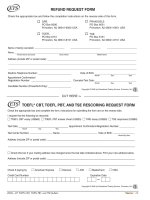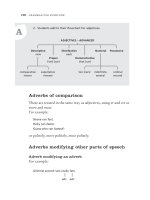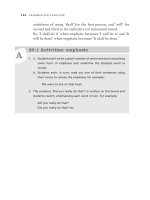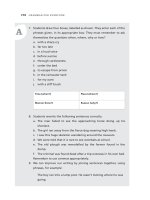Tài liệu Grammar for everyone part 9 ppt
Bạn đang xem bản rút gọn của tài liệu. Xem và tải ngay bản đầy đủ của tài liệu tại đây (124.77 KB, 7 trang )
A
Compare this with the continuous form in which the action of the
verb is still going on.
Thus:
I was cooking, I am cooking, I shall be cooking
The ‘ing’ ending conveys continuity, but the sense is not complete
without the addition of a ‘helper’ or auxiliary verb (see pages
49–52).
3.3 Activities: simple and continuous verbs
1. Provide a scenario, such as: ‘My brother is looking for a job …’
Each student in turn takes the part of the brother. The others ask
him what he can do. He acts out one thing that he can do for the
others to guess, for example:
a. Load a truck
b. Fill ice-cream cones
2. Students change tenses by filling in the spaces:
Past Present Future
a. I shivered I . . . . . . . . . . I . . . . . . . . . .
b. . . . . . . . . . . Jack leaves . . . . . . . . . .
c. . . . . . . . . . . . . . . . . . . . . will break
d. I did not . . . . . . . . . . . . . . . . . . . .
e. . . . . . . . . . . . . . . . . . . . . who will work?
3. Students now fill in the tense tables.
A sample table of tenses
Singular Past
Present Future
1st person I gave I give I shall/will give
2nd person You gave You give You will give
3rd person He/she gave He/she gives He/she will give
46
G rA MMA r for e Ve rY on e
A
Plural
1st person We gave We give We shall/will
give
2nd person You gave You give You will give
3rd person They gave They give They will give
a. Students complete the table with the verb ‘to sing’.
Singular Past Present Future
1st person I shall
2nd person
3rd person He
Plural
1st person
2nd person You
3rd person
A sample table of tenses for an irregular verb
Singular Past Present Future
1st person I was I am I shall/will be
2nd person You were You are You will be
3rd person He/she was He/she is He/she will be
Plural
1st person We were We are
We shall/will be
2nd person You were You are You will be
3rd person They were They are They will be
47
V er bs
A
b. Students complete the table with the verb ‘to go’.
Singular Past Present Future
1st person
2nd person
3rd person He
Plural
1st person We shall
2nd person
3rd person They
A sample table of continuous tenses using the present participle
Singular Past Present Future
1st person I was speaking I am speaking I shall/will be
speaking
2nd person We were
speaking
You are
speaking
You will be
speaking
3rd person He/she/it was
speaking
He/she/it is
speaking
He/she/it will be
speaking
Plural
1st person We were
speaking
We are speaking We shall/will be
speaking
2nd person You were
speaking
You are
speaking
You will be
speaking
3rd person They were
speaking
They are
speaking
They will be
speaking
48
G rA MMA r for e Ve rY on e
A
c. Students complete the table with the verb ‘to achieve’.
Singular Past Present
Future
1st person I was
2nd person You are
3rd person
Plural
1st person
2nd person
3rd person They will be
Auxiliary (helper) verbs
Definition: The word ‘auxiliary’ is formed from the Latin auxilium
meaning ‘help’, and in grammar it refers to certain verbs that are
used to form tenses.
The main ‘helpers’ are taken from forms of the verbs ‘to be’
and ‘to have’. Most native English speakers have little difficulty
with using these forms according to the language that they hear
round about them. They do need explanation, however, and ESL
students will need more practice.
Singular Plural
I am We are
You are You are
He is They are
49
V er bs
A
We need to remember that these forms can be made more tricky
to recognise by the contractions which are common in everyday
speech, but not always fully understood. (See contractions on
page 80.)
For example:
I’ll do it – meaning I shall do it.
He won’t do it – meaning he will not do it.
Similarly, we need to explain that the auxiliary verb can be
separated from the main verb.
For example:
We are definitely going – are going is the verb.
Also, when we ask a question we turn the verb around and
place the pronoun in between.
For example:
Statement: He was telling that funny joke.
Question: Was he telling that funny joke?
Other auxiliary verbs indicate uncertainty and help take on
the role of the subjunctive (see page 146). These need just to be
recognised as verb parts at the earlier stage and will be recognised
through practice. They are can, could, has, have, may, might, shall,
should, will, would and must.
For example:
You must wipe your shoes when you come in.
Rover would not swallow his pill.
3.4 Activities: auxiliaries
1. Students take turns to act or mime an activity. The others guess what
they are doing. They give their guesses in the continuous tense, for
example:
50
G rA MMA r for e Ve rY on e
A
The student acts/mimes drying dishes. The others raise their hands
for one to answer.
He/she is drying dishes.
2. Students are provided with pictures showing various people doing
things, such as working inside a shop, in the market place, in the park
etc. and they say in turn what each is doing, using the continuous
tense.
This activity can also be done in writing and is very useful for ESL
students of any age.
3. Students pick out/mark verbs in a given passage, or in sentences.
They must include the auxiliary parts of the verbs.
I would like to have a party for my birthday but Dad has arranged
a meeting on that day and my brother will be at soccer practice.
I could perhaps make it next week, but that is too soon and I
would have no time to send the invitations. I must decide quickly
so I can start planning. I do hope you can come.
4. Students are provided with a list of verbs in simple tense and they
add the corresponding continuous tense. Again this can be done
orally, on the board or in writing, for example:
hop, hopping
If done as a writing exercise, check the spellings, particularly the
doubling of consonants after the short vowel.
a. stay
b. grip
c. enjoy
d. enter
e. forgive
f. wait
g. behead
h. die
51
V er bs
C
A
i. agree
j. measure
5. Students now fill in the charts on pages 47–49. Other verbs can be
substituted for those given in the previous exercise, especially prac-
tising any that give trouble, either with spelling or tense form.
Checklist: verbs
Students should now be able to:
• define the term verb clearly and accurately
• explain the term tense and classify past, present and future
• give the past, present and future form of a common noun
• explain the terms finite and infinite/non-finite with examples
• supply a subject for a given verb form
• correctly select a verb in a given sentence, recognising a verb in two
parts, i.e. he will laugh
• give examples of the present tense used to indicate habitual action
• complete a tense table using a common verb
• explain the difference between a simple and continuous tense
• change a verb from simple to continuous tense and vice versa
• correctly name the tense of given verbs
52
G rA MMA r for e Ve rY on e









